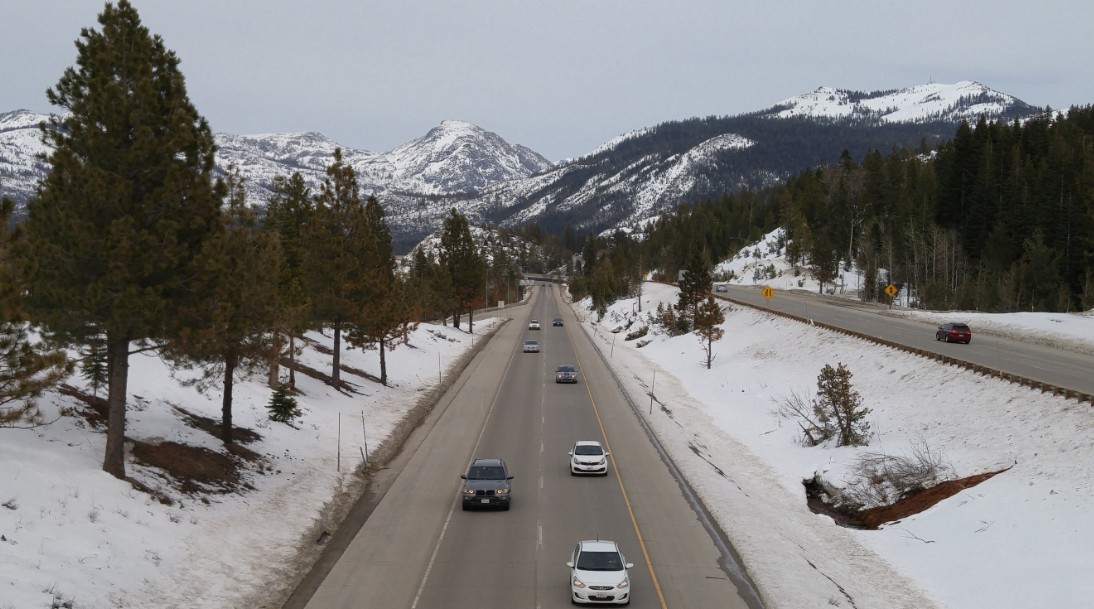California’s statewide snowpack is 25 percent of average for this date, according to Tuesday’s snow survey by the state’s Department of Water Resources.
State reservoirs are still above average for this time of year due to a wet season last year, and strong El Nino conditions are present in the Pacific Ocean and are expected to bring more snow.
“Although El Nino does not guarantee an above average water year, California is preparing for the possibility of more extreme storms while increasing our climate resilience for the next drought,” DWR director Karla Nemeth said in a statement.
Tuesday’s manual measurement was done by the team of Sean de Guzman, the unit manager at the Phillips Station snow course in the Sierra Nevada, where snow measurements have been taken since 1941. It is one of 260 different snow courses measured statewide.
The test involves going to the exact same locations on the site and stabbing the snow-covered ground with a pole for a cookie cutter sample. That sample is then analyzed for its water content and compared to data collected at other times and locations.
At the Phillips station, the snow depth was 7.5 inches with a snow water content of 3 inches. Those findings are 30 percent of average to date for the same site. April 1 is when snowpack is typically at its peak, and Tuesday’s measurement is 12 percent of that average high mark.
That’s in line with DWR’s 130 automated sensors throughout the state, which are finding snowfall at 25 percent of average for this date. Last year’s unusually heavy precipitation resulted in a reading of 185 percent of average on the same date.
“Here at Phillips last year, we were standing on 5 feet of snow,” Guzman said as he stood on a patchy field of snow and brown grasses. “Today’s result tells us it’s really too early to determine what kind of year we’ll have in terms of wet or dry. Luckily our statewide reservoirs are still about 116 percent of average right now.”
“According to our measurements from 1978 to 2019, we are seeing an increase in rain and a decrease in the amount of snowfall,” said Andrew Schwartz of University of California, Berkeley’s Central Sierra Snow Lab, a field research station located in Soda Springs.
“The conclusion that we see from that research is that our snow season is shortening. October and November used to be dominantly snowfall at the snow lab. And we’ve seen October switch to rainfall as well as May. So, we’re seeing a shortening of the season from either end, and there is a lot more rain even in the middle of the winter,” Schwartz said.
In preparation for a potentially rainy winter, DWR is advising all Californians to stay aware of local flood conditions through their county water districts. In a statement, the department says the State-Federal Flood Operations Center has pre-positioned extra flood-fighting materials, including 2.2 million more sandbags, at locations across the state.



Drove up 80 to Reno in late OCT and there was still snow from last year in the peeks shaded side. Also as our population “supposedly” decreases we don’t need as much water as we did “don’t pay attention to the tens of thousands of new houses built and apartments in every city lining the freeways”
sarchasm
Do we really believe that the weather planners know what they’re doing? They can’t even predict what clouds will do yet!
Best job in the world being a weatherman or weather planner. You can be wrong every day and have a great job and people will still love you and never get fired for it. I think they have a back room with Margaritas and a dart board laid out like a pie graph (partly cloudy, clear, sunny, hurricane…) “Wherever that dart lands”
Of course I am having fun here.
I believe the decrease was in the tax paying population. The influx of illegal aliens into CA was close to half a million in 2023 alone. I know a lot of tax payers left, but I do not believe it surpassed 500,000. So it will still matter when the powers that be dump water from our reservoirs into the ocean, and then say we still have a water shortage.
I use this translates into water equivalents for each reporting station, gives color coded percentage ranges.
http://tinyurl.com/amt5bsba
.
CoCo county rain gauges
https://www.ccflood.us/raintable.html
.
Reservoirs by watershed, interesting to see inflows and outflows.
http://tinyurl.com/3b7wcrfh
.
Patience is needed. Statistical averages per date don’t mean much.
.
Meanwhile, always be mindful of your water usage. Don’t be wasteful and we’ll be fine.
.
So we’re still allowed to call it El Niño? 😎
Well…. I’ll be fauxfended if nobody else will.
Atticus, saying “El Niño” is not only racist, it’s also a form of cultural appropriation as well as child exploitation & is a distraction from Man Made Global Warming Climate Change since EN is a “naturally occurring climate phase of rising ocean water temperature” and that’s what you should call it!
Actually “naturally occurring climate phase of rising ocean water temperature” is too long a name.
Anybody have a politically correct name to replace “El Niño” ?
Something short & to the point without invoking religion, ageism, racism, or any other ism that might pizz off the thin skinned PC nannies?
I like “Hot Tuna Tide”